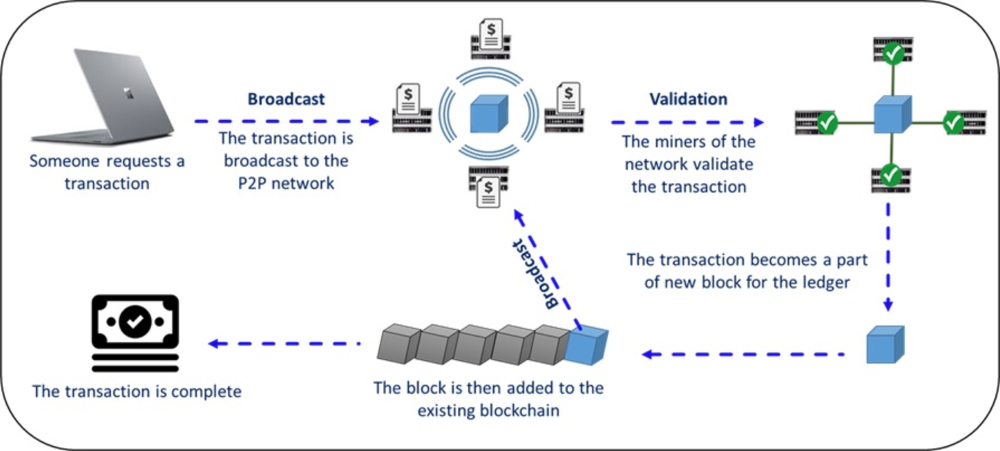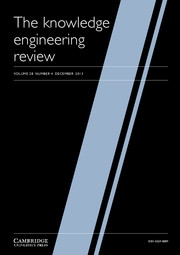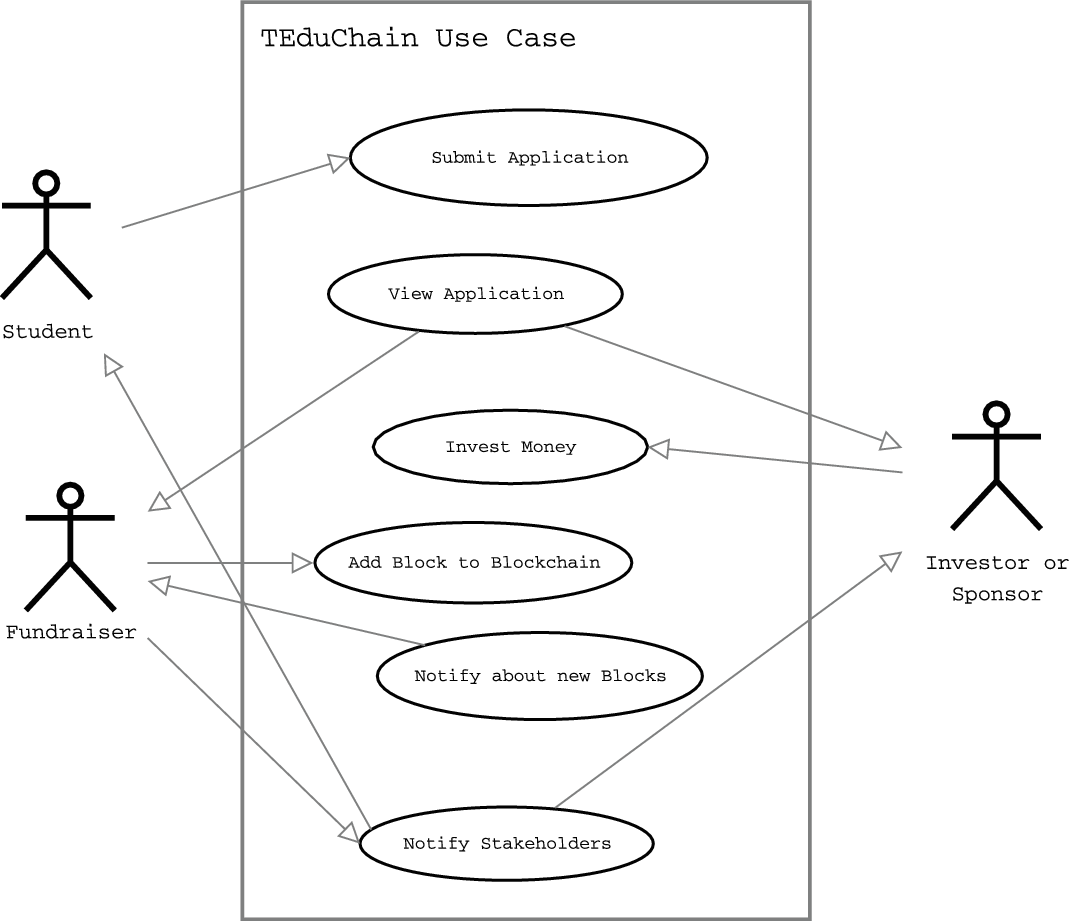1 Introduction
The blockchain network (Morris, Reference Morris2016; Popper, Reference Popper2016), originally known as blockchain (Brito & Castillo, Reference Brito and Castillo2013; Trottier, Reference Trottier2016), is a continuously growing records stored in blocks where the blocks are linked together using cryptographic hashes.
In this work, we propose a platform for funding needy students for their tertiary education based on the concept of blockchain technology (Blockchain Luxembourg S.A. 2019). The system exploits the benefits of the blockchain, as a decentralized architecture (Figure 1), offering secure long-term investment mechanism, integrity, and transparency, in order to create a globally trusted funding system for poor undergraduate and postgraduate students who wish to continue their higher education. Note that the preliminary work of this paper was presented in a Distributed Ledger Technology Symposium (Rashid et al., Reference Rashid, Deo, Prasad, Singh, Chand and Assaf2018).

Figure 1 Decentralized Blockchain Architecture. A member of the network broadcast an intention for a transaction, the miners validate the transaction, a block is created upon transaction and finally, the new block is added to the chain and broadcast to the network with the linking hash
It is believed that talented high school students should not be prevented to have the opportunities to pursue university education towards building professional careers that only fortunate students get. By revolutionizing the funding scheme through blockchain technology, we can give every talented student the opportunities that they deserve. The use of blockchain allows the fundraiser to track the investors and students knowing that the information is true as they are the part of the chain which has been verified by the transparent distributed system. The objectives of the platform can be summarized as follows:
A blockchain technology-based decentralized platform that allows students to attain funding by selling their future revenue rights to investors worldwide. This could be enforced directly by setting up a policy with the nation’s revenue management authority to monitor these students future income. Once they start earning, a certain amount from their income could be withheld automatically and sent that to the fundraiser who could than reimburse the investors.
The investment process is automated and it uses the concept of contract among the student and the sponsors facilitated by the fundraisers.
The investments are liquid assets that can be converted to tokens at any time.
The scientific contribution of this work is to provide a distributed and interoperable architecture model for the higher education scholarship, sponsorship, or study loan schemes which addresses the global benefits of the students, the educational institutions, and the potential investors. As a proof of concept and for validation purposes, we developed a prototype of the platform from scratch written in Java 8 SE. With the traditional system, there is only one instance of the entire record and changing the contract information of any student maliciously would go undetected. With blockchain, a little tempering with any record would easily be identified.
Students can take advantage of having their university tuition fees and cost of living for the study period covered by a transparent bursary schemes. The investors contributing to this scheme will get reimbursed plus awarded a percentage of what a student would be making from their work after graduation for a predefined period of time. In the following section, we present a brief literature review of the technology.
2 Related work
Blockchain technology is used in several domains, such as healthcare management (Yli-Huumo 2016), clinical trials (Shae et al., 2017), pharmaceutical industry (Mettler, Reference Mettler2016), smart business, electronic government (Hou, Reference Hou2017), sports, logistics (Yuan et al., Reference Yuan and Wang2016), intelligent transportation systems (Lei et al., Reference Lei, Cruickshank, Cao, Asuquo, Ogah and Sun2017), and higher education credit systems (Turkanovic et al., 2018) due to its benefits in distributed data storage, transparency, and decentralized environment where no third party is in control of the transactions (Roehrs et al., Reference Roehrs, da Costa and da Rosa2017).
In Mengelkamp et al. (Reference Mengelkamp, Notheisen, Beer, Dauer and Weinhardt2017), energy production, management, and trading using smart grids and blockchain technology are discussed, and a model for business operation optimization is proposed. The research domain of Internet of Things and how it can benefits from blockchain technology including security, management, and privacy issues has been addressed in literature (Conoscenti et al., Reference Conoscenti, Vetró and De Martin2017; Ouaddah et al., Reference Ouaddah, Elkalam and Ouahman2017; Dorri et al., Reference Dorri, Kanhere, Jurdak and Gauravaram2017).
Solutions related to higher education using blockchain technology and cryptography such as creating, sharing, and verifying digital academic certificates and credit-based achievements have been investigated and employed by several higher education institutions in Europe and South America (Bond et al., Reference Bond, Amati and Blousson2015; Third et al., Reference Third, Domingue, Bachler and Quick2016; Media 2019).
The posibilites of blockchanin adoptation in education is highlighted in Harthy et al. (Reference Harthy, Shuhaimi and Ismaily2019). In Turkanovic et al., (2018), a blockchain-based global university credit system is presented. They proposed a simplified and efficient solution for sharing student’s credit record with other higher education institutions, while eliminating language and administrative obstacles; additionally, the system is publicly accessible on the web via internet. A parallel intelligence and parallel blockchain in education are proposed in Gong et al. (Reference Gong, Liu, Jing, Xiong and Zhou2019), and the applications of Smart Blockchain Badges on data science education are explored in Mikroyannidis et al. (Reference Mikroyannidis, Domingue, Bachler and Quick2018). Furthermore, the effectiveness of blockchain technology for the distributed registry in education (Naumova et al., Reference Naumova, Svetkina and Naumov2019). The methodology is presented next.
3 Our platform
In this paper, we propose a complete platform named TEduChain to collect and manage funds for students for higher study and administer them afterward. Three different entities—fund seeking students, fundraisers, and sponsors are the actors of the platform as shown in Figure 2. The platform provides customized dashboards for different entities. The entities interact with each other efficiently using their own dashboards. A brief description of the entities is presented below:

Figure 2 Use Case Diagram. Students, fundraisers, and investers are the three primary actors of the platform. Their interactions are also presented here
Students: Students are the entities who seek fund for their tertiary study as scholarship, donation, or study loan in terms of sponsorship. If the fund comes through the investors as a loan, the students need to repay the loan based on the defined terms and conditions of the loan. The students must express their interest first through the platform to include them into the blockchain network.
Fundraisers: Fundraisers are the licensed business entities who work as intermediary agents to collect funds for the students and after securing the funds they manage the students’ portfolios. The fundraisers are part of the system as the representative of the students. They represent the students to the investors and collect funds for the students. The fundraisers also act as the miners in the network, and once the full amount needed by a student is collected, they prepare a document (contract) that binds the student and the respective investors. The fundraiser entities are the traditional scholarship bodies located in different countries all over the world. Fundraisers play the important role for validating, authenticating, and maintaining student applications and their records.
Sponsors: The sponsors could be individuals or business organizations—scholarship providers, philanthropists, or investors—who are committed to fund for tertiary education through one or multiple fundraisers. Every sponsor has their own terms and conditions for the sponsorship schemes. The investors have their virtual wallets and their balances will be changed upon the commitments to invest to any student.
Note that the entities must be registered to the platform prior to accessing their personalized dashboards.
3.1 Architecture of the platform
The proposed TEduChain platform (see Figure 3(a)) consists of two different operational frameworks: a relational database-driven administrative framework and a distributed ledger-based blockchain framework.

Figure 3 (a) The architecture of the TEduChain platform. For crowdfunding tertiary education and managing the contract afterward, three different entities interact with the platform: (i) students, (ii) sponsors, and (iii) fundraisers. (b) The workflow of the platform. The process begins when a student applies for funding
Administrative Framework: Regular operations, such as creating user account, resetting password, sending email notifications to the users, uploading profiles, modifying personal information, resolving conflicts among the entities, providing the dashboards, and other housekeeping functionalities, are managed and maintained by the administrative framework. This framework is driven by a central relational database management system. The administrative database stores student verification data, and list of fundraisers and investors in the system and is also used for registration of the students and the investors while the blockchain database stores the students and investors details and the amount of fund given by each investor after mining is completed, that is, after a student gets the full amount needed for any particular program to study. The three different entities interact with the platform using their respective dashboards. Through their personalized dashboards, the students submit their applications, update their personal information, upload additional supporting documents for their application, and monitor the status of their application. Through their personalized dashboards, the fundraisers publish the list of the eligible students seeking for funds and also push the list to their pool of sponsors. The fundraisers can monitor the current status of accumulated funds of every students in the list. The sponsors can interact with the platform through their personalized dashboard. They can apply to join a new fundraiser’s pool, can track the status of the students they are bidding for, can see the balance of their wallets, can add more virtual money to their wallets, and can change their terms and conditions of funding for future investments.
TEduChain Framework: The contract among the students and the sponsors are securely stored in new blocks, mined, and appended them to the chain using TEduChain framework. This framework is responsible for collecting all required information from the administrative framework at the time of generating the contract documents among the parties. The use of blockchain here is not similar to that of bitcoin or any other cryptocurrency network. Our aim is to collect funds for students and to keep it as transparent as possible. This will be a public blockchain, anyone would be able to be a part of it. There can only be three types of participants in the framework—student, fundraiser, and investors. The issue of consensus in our case is solved by which fundraiser is able to collect the full funds for any particular student first. If a fundraiser is able to collect the total funds for a particular student, the fundraiser will be able to add the student and the investors to the blockchain. The fundraiser also has the right to link the block to the chain.
3.2 How the platform works
Any entity interested on this platform needs to create an account first. The information required to create an account is specific to the entity type. For example, to be registered as a fundraiser, the entity should provide a valid business identification number. On the other hand, the system will require financial information in case of a sponsor.
After validating the registration request by the platform, the entities will find their personalized dashboard upon sign-in to the system. They can interact with the platform using their own dashboards.
A typical workflow presented in Figure 3(b) begins when a student successfully sign in to his account and landed to his personalized dashboard. The student submit a prescribed application form to the system seeking for fund. The student need to provide the detailed information in the form, such as the name of the study program, the name of the educational institute, the high school results, the family income, and so on. The platform’s central repository will have preloaded information to verify the eligibility of the student and notify the student with the outcome. If the student is eligible, the platform will publish the detail and the student will be automatically added to the sorted list on the fundraisers’ dashboards. The student will also be appeared in the list on the sponsors’ dashboards.
A sponsor might fund a student either in full or partially through one or multiple fundraisers. The fundraiser who will be able to secure the full amount first will get the right to generate the contract between the student and the sponsor/s. The winner will also get the right to manage the portfolio of the student afterward. After winning the student, fundraiser will create a transaction, store the transaction in a new block, add the block to the chain, and broadcast the block and the linking hash in the blockchain network for others to update their distributed ledger. Finally, the student will be removed from the active list. The funding commitments received by the unsuccessful fundraisers from their investors are rolled back at this point, and the wallet of the investors will be credited automatically. A few of the administrative interfaces are presented in Figure 4.

Figure 4 A snapshot application prototype. (a) the home page allow users to either register or log in to the application; (b) once logged in, students can apply for fund and then monitor the status using student dashboard; (c) the fundraisers intract with the system using the fundraiser dashboard; and (d) the investors intract with the system using the investor dashboard
3.3 Implementation details
A detailed class diagram is presented in Figure 5 with the implemented classes in the application with their properties and methods. The other technical artifacts of the blockchain implemented in TEduChain platform are presented below:
The mining process: Each fundraiser manages a local database to store temporary record of active students who have received some amount by the sponsors however, yet to reach their total amount they need for a particular program to study. During the mining process, the fundraisers continuously check the balance amount in their local database that yet to be collected for every active student. Once the collected amount has reached the desired amount, the fundraiser notifies other fundraises to stop collecting fund for the student and remove him from their active list as the fundraiser has won the student. The fundraiser then goes on to prepare the block for that student and includes all the details that binds the student, the sponsor/s, and the fundraiser.
Linking the blocks: Once the block is prepared, the fundraiser fetches the hash of the last block in the chain and adds it in the current block. The fundraiser then calculates the hash of the block using SHA-256 algorithm on all of the containments in the block including the hash of the last block of the chain. The fundraiser links this block to the chain and broadcast that block in the network for other fundraisers to update their distributed ledger. Once this process is completed, the fundraiser continues mining for other students.
Distributing the contract information: During the linking process, the details are put into a document and sent them to the appropriate student and sponsor/s for their own reference via the email they registered with. Note that the document’s hash is also stored in the block. This is just like the traditional legal document signed in between the parties; however, it is generated automatically by the fundraiser after mining which includes the details, for example, the program cost, program duration, student and respective investors, how much did each investor contribute, and benefits to the investors after the student gets a job.
Verifying the blockchain: The fundraiser verifies the chain by generating the hash of the block using all of its contents excluding its own hash and comparing with its stored hash.
Changing block contents: It is not possible to make changes to a previously added block; however, in some cases, where the student’s or investor’s personal details need to be changed, a copy of the old block is obtained and necessary changes are made to it and added to the chain again as a new block. This does not do any modification to the old block and remains as it was. Note that only the student’s and investor’s personal details are allowed to be changed in the new block, such as address and contacts—the terms and conditions of the contract are immutable.

Figure 5 Class Diagram. The diagram presents the classes implemented in the application with their properties and methods
4 Conclusion
This work is based on a noble cause to support poor students. Talented students should not be deprived of tertiary study for the lack of financial supports from their families. This platform will create opportunities for the underprivileged students by outsourcing funds for their tertiary study that could not be possible by themselves.
Acknowledgment
The authors would like to thank the anonymous reviewers for their valuable comments and suggestions to improve the quality of the paper. They are also grateful to Prof. A. Sharma, Dr K. Chaudhary, Prof. S. Naidu, Dr A. Sharma, and Dr T. Sarker for their support and guidance during the implementation and writing phase of this work.







